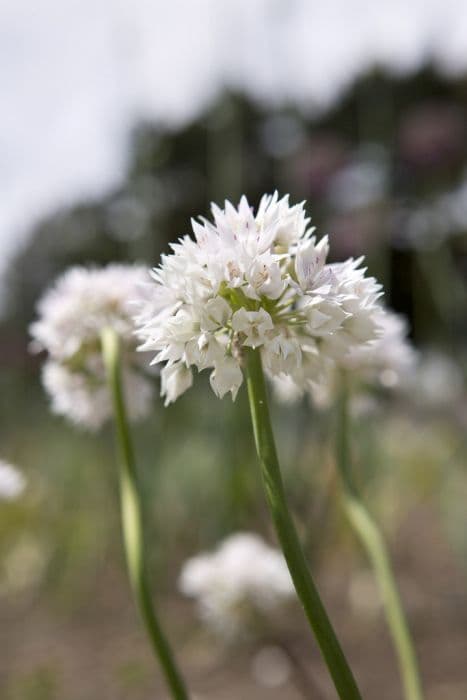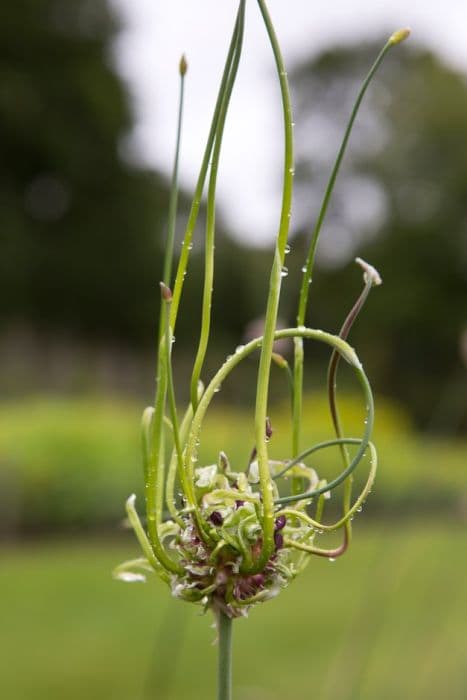Spring Starflower Ipheion 'Alberto Castillo'

ABOUT
Ipheion 'Alberto Castillo' is a flowering plant known for its delicate and attractive blooms. The appearance of this plant is characterized by its star-shaped flowers that are typically white with a hint of iridescence, creating an almost sparkling effect in the sunlight. Each flower has six slender petals spreading out from the center in a radial pattern. The center of the flower typically houses subtle, soft yellow to greenish stamens that complement the white petals. The foliage of Alberto Castillo is narrow and grass-like, with a soft, linear form that gently arches and sometimes gives a tufted appearance. The leaves emerge in a lush green color, providing a contrast to the purity of the white flowers. Both the leaves and flowers emerge from a bulb nestled within the soil. The plant has an overall graceful and airy feel with its blooms often described as light and elegant, adding a touch of brightness wherever it is planted.
About this plant
 Names
NamesFamily
Amaryllidaceae
Synonyms
Spring Starflower, Springstar
Common names
Ipheion 'Alberto Castillo'.
 Toxicity
ToxicityTo humans
The plant commonly known as Spring Starflower (Ipheion 'Alberto Castillo') is not widely recognized as toxic to humans. While there are no significant reports of toxicity, as with many plants, it's advisable to prevent ingestion to avoid any potential gastrointestinal discomfort or allergic reactions. There is no well-documented evidence of severe poisoning symptoms in humans associated with this plant.
To pets
The Spring Starflower (Ipheion 'Alberto Castillo') is also not considered highly toxic to pets. However, caution should be taken since the exact toxic properties may not be fully researched. If a pet ingests part of the plant, keep an eye on them for any signs of gastrointestinal upset such as vomiting or diarrhea, and consult a veterinarian if you observe any abnormal behavior or symptoms.
 Characteristics
CharacteristicsLife cycle
Perennials
Foliage type
Deciduous
Color of leaves
Green
Flower color
White
Height
6 inches (15 cm)
Spread
6 inches (15 cm)
Plant type
Bulb
Hardiness zones
5
Native area
South America
Benefits
 General Benefits
General Benefits- Easy to Grow: The plant is known for its low maintenance and ease of cultivation, making it a good choice for both beginner and experienced gardeners.
- Drought Tolerant: Once established, it can withstand periods of low water, requiring minimal irrigation and care.
- Attracts Pollinators: It produces flowers that attract bees, butterflies, and other beneficial insects, promoting biodiversity in the garden.
- Spring Bloom: The plant typically flowers in early spring, providing a splash of color after the winter months.
- Naturalizes Well: Over time, this plant can spread and naturalize in the garden, creating larger displays of its blooms.
- Cold Hardy: It is resistant to cold temperatures and can survive frost, making it suitable for gardens in cooler climates.
- Long Blooming: The blooming period lasts for several weeks, providing a long-lasting display of flowers.
- Low Pest and Disease Problems: It is generally resistant to common garden pests and diseases, reducing the need for chemical treatments.
- Versatile Planting: Suitable for planting in a variety of garden settings including borders, rock gardens, and as ground cover.
 Medical Properties
Medical PropertiesThis plant is not used for medical purposes.
 Air-purifying Qualities
Air-purifying QualitiesThis plant is not specifically known for air purifying qualities.
 Other Uses
Other Uses- Photography: Ipheion 'Alberto Castillo', or spring starflower, due to its striking white flowers, can be an excellent subject for botanical photography and macro photography experiments.
- Naturalizing in Lawns: Spring starflower bulbs can be scattered to naturalize in grassy areas, creating a whimsical meadow-like effect as they bloom in spring.
- Educational Tools: Biology teachers sometimes use spring starflowers to help students learn about plant growth, bulb propagation, and flowering plants' life cycles.
- Artistic Inspiration: Artists can draw inspiration from the aesthetic appeal of spring starflowers for paintings, illustrations, and fabric designs.
- Garden Borders: These plants are often used to create low borders around garden beds or walkways, adding vibrant white touches to the landscape design.
- Culinary Garnish: Although not widely known for their culinary use, spring starflower blossoms may be used as edible garnishes to decorate salads and desserts, provided they haven't been treated with pesticides or other chemicals.
- Wedding Decor: Fresh or dried spring starflower blooms can be incorporated into wedding bouquets, table arrangements, and boutonnieres for a natural and delicate touch.
- Pattern Design: The star-shaped flowers can serve as inspiration for creating repetitive patterns in graphic design, textile design, and wallpaper.
- Children’s Gardens: Spring starflowers, with their hardy nature and gentle appearance, are a great addition to children’s gardens to stimulate young imaginations and interest in horticulture.
- Floral Arrangements: Spring starflower can be used in small floral arrangements and posies, bringing a splash of early spring charm indoors.
Interesting Facts
 Feng Shui
Feng ShuiThe Spring Starflower is not used in Feng Shui practice.
 Zodiac Sign Compitability
Zodiac Sign CompitabilityThe Spring Starflower is not used in astrology practice.
 Plant Symbolism
Plant Symbolism- Purity: The Ipheion 'Alberto Castillo', commonly known as the Spring Starflower, often symbolizes purity due to its clean, crisp white flowers that evoke a sense of freshness and innocence.
- Hope: Its early spring blooming can represent hope, as it is one of the first flowers to emerge after the winter, signaling the coming of warmer days and the renewal of life.
- New Beginnings: Similarly, the Spring Starflower is associated with new beginnings for its role in heralding the onset of spring, a time when nature awakens from its slumber.
- Fortitude: Despite its delicate appearance, the Spring Starflower is quite hardy and resilient, often representing fortitude and the ability to thrive in challenging conditions.
 Water
WaterThe Spring Starflower should be watered moderately when its soil surface feels dry to the touch, typically once every week to maintain consistent moisture during the growing season. In established gardens, normal rainfall is often sufficient, but in periods of drought, additional water may be needed. Care should be taken to avoid overwatering, as this can lead to bulb rot. When watering, aim for about a gallon of water per square yard each week during active growth.
 Light
LightSpring Starflowers thrive best in full sun to partial shade. An ideal spot would provide direct sunlight for at least six hours a day, but they can also tolerate light dappled shade. Ensure they are not placed in deep shade, as this would compromise their bloom and overall vigor.
 Temperature
TemperatureSpring Starflowers prefer temperate climates with ideal temperatures ranging between 55 and 75 degrees Fahrenheit. They can withstand temporary variations between 28 and 86 degrees Fahrenheit, but should not be exposed to extremes for prolonged periods. Offering some shade during the hottest part of the day can help in maintaining suitable temperature conditions.
 Pruning
PruningPruning is not typically necessary for the Spring Starflower, but deadheading the faded blooms can encourage more flowers. Prune back foliage only after it has died down naturally in late summer or early fall, as the leaves provide nutrients for the bulbs for the next growing season.
 Cleaning
CleaningAs needed
 Soil
SoilSpring Starflower prefers well-draining, fertile soil with a pH ranging from 5.5 to 7.5. A mix of loamy garden soil, compost, and sharp sand or perlite is ideal to ensure proper drainage and nutrient availability.
 Repotting
RepottingSpring Starflowers are not commonly repotted as they are perennial bulbs; divide clumps every 3-4 years to maintain vigor and flower production.
 Humidity & Misting
Humidity & MistingSpring Starflower thrives in average humidity conditions; they do not require any special humidity considerations and can adapt to the typical outdoor environment.
 Suitable locations
Suitable locationsIndoor
Ensure bright light, occasional watering, and cool temperatures for indoor Spring Starflowers.
Outdoor
Plant in well-draining soil, full sun to partial shade, and water moderately.
Hardiness zone
5-9 USDA
 Life cycle
Life cycleIpheion 'Alberto Castillo', commonly referred to as the Spring Starflower, begins its life cycle as a bulb that sprouts in early spring. The plant quickly develops narrow, grass-like leaves and a flower stalk, which soon bears a star-shaped, white flower with a delicate fragrance. After blooming, typically from mid to late spring, the Spring Starflower sets seed, which can be dispersed to propagate the plant. As temperatures rise in late spring or early summer, the plant enters a period of dormancy, with its foliage dying back. The bulb remains dormant underground throughout the summer and possibly part of fall, conserving energy for the next growing season. With the onset of cooler weather and sufficient moisture, the cycle restarts as the bulb breaks dormancy and begins to sprout once more.
 Propogation
PropogationPropogation time
Spring to summer
Propogation: The Spring Starflower 'Alberto Castillo' is commonly propagated by dividing the bulbs, generally done in the late summer or early fall, once the foliage has died back. The way to propagate this plant is to gently dig up the bulbs and detach any offsets, which are the small bulbs that form at the base of a mature bulb. These offsets can be immediately replanted in well-draining soil at a depth of about 3 inches (roughly 7.5 cm) with spacing of at least 3 inches (7.5 cm) apart. This will give them sufficient time to establish roots before the onset of winter, resulting in blooming in the following spring. It is important to ensure that the soil is kept moderately moist but not waterlogged to foster healthy growth.








